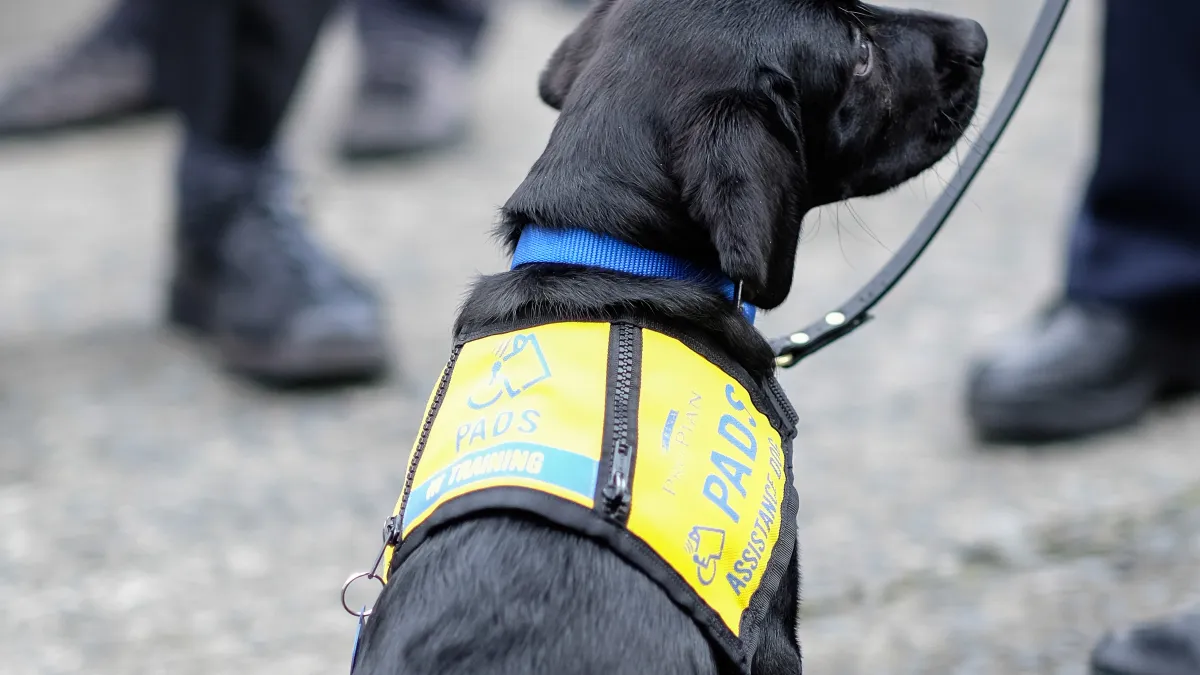Most employers are familiar with requests for service animals, especially for service dogs, which can help employees with both physical and psychiatric disabilities by checking rooms, opening doors, detecting when they are on the verge of a seizure and more. Service animals can keep workers safer and workplaces more copacetic, but they also make HR understandably wary.
"The three questions I get most often are: Where is it going to use the bathroom? What do I do if my employees are allergic to dogs? And what do I do if employees are afraid of dogs?" Joanne Lambert, office managing principal at Jackson Lewis P.C., told attendees at the 2019 Disability Management Employer Coalition annual conference.
The increased popularity of "comfort animals" and the proliferation of unseen disabilities, such as PTSD, and conditions like depression and anxiety, further complicate things, Lambert said. To understand the potential boundaries and solutions when service animal requests surface, Lambert offered advice in response to popular questions she hears from employers.
What do I do if my employees are allergic to (or afraid of) dogs?
Allergies can invoke a reflexive "no" from HR pros fielding requests for service animals, Lambert said, but that response is not in anyone's best interest. "We all know under the [Americans with Disabilities Act], that is not the way to go. You gotta go with the interactive process," she said.
A worker's request for a service animal cannot be denied because another worker is allergic to the animal, so engaging in the interactive process to attempt to accommodate their disability, familiarizing oneself with the Americans with Disabiltiies Act (ADA) and checking on state laws regarding service animals are safe next steps for employers, Lambert said.
HR might try to separate the allergic employee and the employee with the animal by putting them in separate or private work areas, permitting flexible scheduling for them or creating a schedule for the use of common work areas, Lambert told attendees. The organization can arrange for its workplace to be cleaned more frequently to keep dander at bay — or even ask the worker if they'd be willing to use dander-reducing products on their animal, Lambert said.
"Employees have to work with you on accommodations," she reminded attendees. HR may also have to engage pet-phobic employees in their own interactive process if their fear rises to a "medical level," she added.
When (and where) is the dog going to use the bathroom?
"I like to liken this to lactation breaks," Lambert said, meaning that if workers with service animals choose to use their paid breaks to toilet their animals, then they must be compensated during those breaks. Additionally, flexible break times or adjusted break times can be a reasonable accommodation for this purpose, Lambert noted, although employers can ask workers to schedule those breaks around busy work periods.
Furthermore, it is not incumbent on the employer to furnish a "potty area" for service animals. Employers can require workers to clean up after their service animals if they are not housebroken and, according to Lambert, it can become a performance issue for the worker if customers or co-workers step in their service animal's mess. If a service dog is not potty-trained, it is permissible to deny the worker's request in the first place, Lambert noted.
Fear of dog poo by the water cooler may be HR's first instinct, but Lambert argued that this is unlikely to be an issue with trained service dogs anyway.
"Don't assume they're going to disrupt the workplace. Most animals can even go hours without needing to relieve themselves," she said. "Generally, they are so well trained, you won't even know the service animal is there."
Do I have to accommodate comfort animals?
The ADA defines a service animal as "a dog that has been individually trained to do work or perform tasks for an individual with a disability. The task(s) performed by the dog must be directly related to the person's disability."
Unlike service animals, emotional support animals do not perform specific tasks, but merely benefit workers by being present, Lambert said. Employers have to accommodate service animals, including psychiatric service animals, but they may be able to reject an employee's request for an emotional support animal.
"'I need them with me because they just make me feel safer,' that may not rise to the level of a task," Lambert explained, while acknowledging that comfort animals still alleviate symptoms for workers. Employers should tread lightly, she said, because emotional support animals oftentimes perform tasks that qualify them as a service animal for workers with severe depression or PTSD.
"You should always be careful before excluding an emotional support animal," Lambert said. "I think the trend right now is to look at emotional support animals and see if they don't apply to a psychiatric accommodation."
What documentation can I ask for?
Per the ADA, it's acceptable for an employer to ask for medical documentation that verifies a worker's disability while engaging in the interactive process. These requests are most valid when the worker's condition is unseen.
"I always say, don't play doctor," said Lambert, who reminded attendees that it's a bad idea to ask workers for medical proof of their disability when that disability is obvious, as with workers who use wheelchairs. "Let the process play itself out, and don't make knee-jerk decisions."
Employers are also allowed to ask the worker if their service animal is trained, but the animal can be self-trained by the worker, Lambert said, citing the U.S. Equal Employment Opportunity Commission.
"The bottom line is, you are not entitled to have you employee go and get some specific training," she said. For employers who are concerned about the animal's behavior, some opt to grant service animals as an accommodation on a trial basis, Lambert said, giving the employee an opportunity to prove that their animal is trained and non-disruptive.
When can I say 'no' to a service animal request?
As with allowing work-from-home schedules or sit-and-stand desks, "If I agree to it, then everyone will want it" is not a valid reason to exclude a worker's service animal, Lambert said. Exclusion is reasonable if the dog:
-
Is not needed to help the worker with their disability.
-
Is not trained or housebroken.
-
Is out of control in the workplace.
For this last example, Lambert said employers ought to give the worker "reasonable opportunity" to gain control of their animal. HR might also reflect on its reaction to the disruptions service animals cause, Lambert said. For instance, how might one react to a dog barking in the workplace compared to a similar disruption from an employee, such as yelling across the sales floor?
She also urged employers not to automatically exclude specific breeds that have been stereotyped as aggressive, like pitbulls, and to instead evaluate them based on their training and behavior.
Allowing service animals in the workplace can get hairy, particularly for public-facing businesses, but creating policies for service animals and documenting service animal expectations and consequences for unacceptable behavior can help, Lambert said. Training supervisors and security staff to contact HR before removing a worker's service animal is also a safe practice, she added.
"They're people first, they're not people with disabilities," Lambert said, explaining to attendees that requests for service animals are less complicated when HR engages its humanity.






















